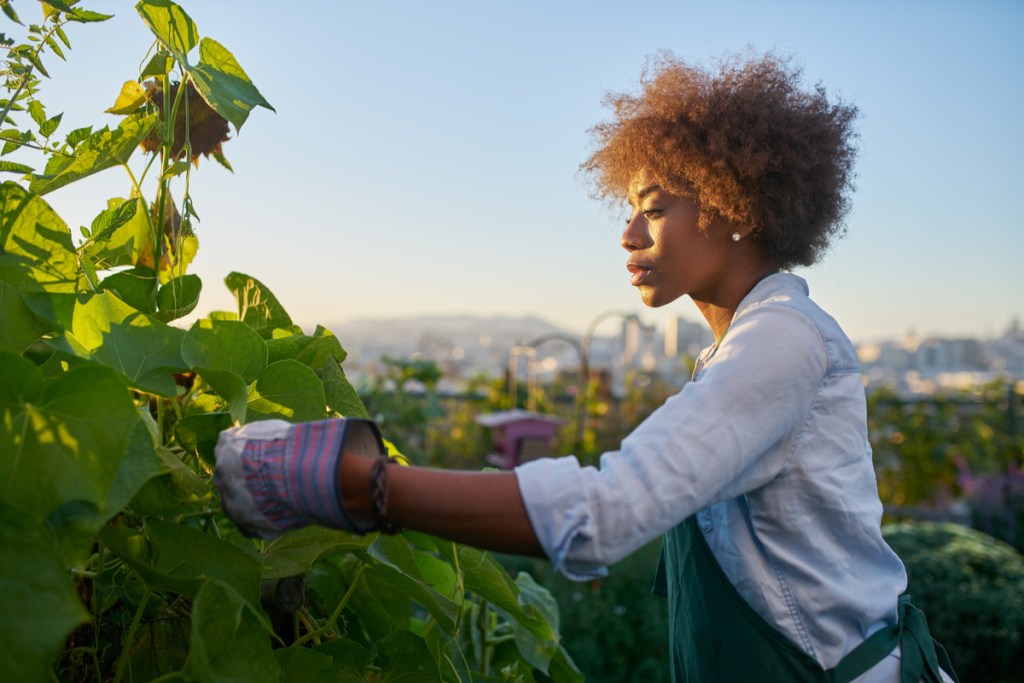Gardening: it’s a hobby, a lifestyle, a passion. But did you know you can also utilize gardening as exercise? It’s true! Gardening can actually benefit your health in so many ways, and with a few focused changes, you’ll be able to turn your routine into a workout just in time for National Gardening as Exercise Day.

Is gardening really a workout?
The American Heart Association considers gardening to be a form of moderate-intensity exercise. Not only are you getting your body moving, but you’re also engaging muscles in your legs, arms, and core as you dig holes, rake leaves, and squat down to pull weeds and plant seeds. It keeps your joints and bones moving, gets you outside for some fresh air, and let’s face it, who doesn’t love counting their passion as their daily workout routine?
Gardening can also help you maintain a healthy bone density. A study done by the University of Arkansas found that “bicycling, aerobics, dancing, yard work, and weight training were linked to higher levels of mineral density. The researchers then performed a regression model analysis — a statistical assessment that examined each activity independently, ensuring that no two overlapped. The results showed only two activities to be significant for maintaining healthy bone mass — yard work and weight training.”
Although gardening is a good workout practically speaking — it engages the four main types of exercise: balance, strength, flexibility, and endurance — it’s also good for the mind. You’re outside in fresh air, soaking up sunlight, and you get the satisfaction and reward of admiring your hard work when it’s done.
How it can improve your overall health
People who utilize gardening as exercise enjoy a variety of health benefits, including a reduction in BMI. Studies have linked gardening with weight loss, showing that the odds of gardeners becoming overweight are lower than that of nongardeners. Plus, there’s nothing better than growing your own fruits and veggies! Gardening encourages you to adopt a healthier lifestyle by growing your own salad makings in your backyard. It fosters a feeling of deep satisfaction that you were able to successfully grow something edible as well as enjoy its delicious taste. It’s much more rewarding than a trip to the store!
It benefits your mental health, too!
Although the physical benefits are great, gardening has the ability to improve your mental well-being, too. You get time in the sun to absorb some vitamin D, which not only improves your mood but is a vital nutrient for organs like the brain and heart. Plants also enhance a sense of relaxation and comfort, decreasing stress and anxiety (if only for a short time). And when we look at a larger scale, community gardening can help decrease feelings of isolation and loneliness. Even if you aren’t directly interacting with anyone, you’re around other people doing something you love, and that creates a sense of belonging.

Ways to enhance your gardening routine
So, what can you do to help make your gardening routine a workout? It’s actually easier than you think. There are five simple steps you can take to make sure you’re getting the most out of the hobby you love:
- Increase your range of motion when raking or weeding. Gradually reach further and further within your limits, slowly stretching and engaging different muscles.
- Use those larger muscles. Engaging your glutes, core, and quadriceps while gardening will help keep soreness at bay, take the strain away from smaller muscles in your arms and lower back, and help you burn more calories.
- Adopt the lunge-and-weed method outlined in Jeffrey Restuccio’s book, “Aerobic Gardening.” In a lunging position, rest your left arm on your left knee and weed with your right hand. This method makes use of a long-handled tool, since you’ll need to make sure your back stays upright. It may take some practice, and you can easily alternate hands if you need or want to by lunging with the other leg.
- Turn your tasks into repetitions and sets. When raking, this can be something like 10 brisk sweeps, rest, repeat. This won’t work for everything, so you’ll have to evaluate what can be turned into repetitions based on your own routine.
- Balance it all out. If one arm is outstretched, bring the other in. If one leg is forward, put the other back. Balance is key here to prevent any muscles from being strained or overused and it evens out how much each one is being worked.
For people who love to grow their own plants and tend to flowers, utilizing gardening as exercise will help save time in your day and be an enjoyable form of exercise. You get to grow your own greens, help beautiful flowers bloom, and spend some much-needed time outside while improving your bone density, boosting your mental health, and keeping your heart healthy.


